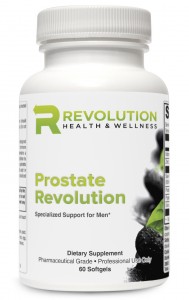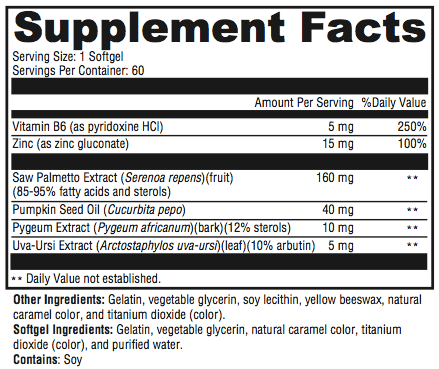Prostate Revolution

Pygeum Africanum Bark Extract (Pygeum africanum), used for approximately 300 years, blocks androgen precursors, reduces prolactin levels, and has a decongesting, or anti-edema, effect. In animal models, Pygeum modulates bladder hypercontractility. The bark extract increases prostatic secretions and improves seminal fluid composition.[9] In 2007, a critical review of this plant’s efficacy examined a detailed series of in vitro and in vivo studies on prostate growth and bladder function. Researchers identified molecular targets of Pygeum africanum extract affecting both growth factor-mediated prostate growth and specific parameters of bladder function.*[10]
Pumpkin Seed Oil Extract (Cucurbita pepo) is naturally rich in phytosterols, antioxidants, and unsaturated fatty acids (55% linoleic acid). A randomized, controlled, double-blind, three-month study (n=53) reported significant improvement in urinary flow, urination time, residual urine, and urinary frequency without any adverse effects.*[11]
Uva-Ursi Extract (Arctostaphylos uva-ursi), derived from the Uva-Ursi leaf, contains 10% of the glycoside, arbutin, beneficial for its anti-microbial and diuretic properties.*[12,13]
Zinc inhibits 5a reductase, the enzyme that converts testosterone to its more potent form, dihydro-testosterone, believed to be most responsible for proliferative changes to the prostate.*[14]
Directions
Take 1 softgel twice daily
References
1. Wilt T, et al. Serenoa repens for benign prostatic hyperplasia. Cochrane Database Syst Rev. 2002;(3):CD001423. [PMID: 12137626]
2. Marks LS, et al. Tissue effects of saw palmetto and finasteride: use of biopsy cores for in situ quantification of prostatic androgens. Urology. 2001 May;57(5):999-1005. [PMID: 11337315]
3. Plosker GL, Brogden RN. Serenoa repens (Permixon). A review of its pharmacology and therapeutic efficacy in benign prostatic hyperplasia. Drugs Aging. 1996 Nov;9(5):379-95. [PMID: 8922564]
4. Di Silverio F, et al. Evidence that Serenoa repens extract displays an antiestrogenic activity in prostatic tissue of benign prostatic hypertrophy patients. Eur Urol. 1992;21(4):309-14. [PMID: 1281103]
5. Vacher P, et al. The lipidosterolic extract from Serenoa repens interferes with prolactin receptor signal transduction. J Biomed Sci. 1995 Oct;2(4):357-365. [PMID: 11725073]
6. Wadsworth TL, et al. Saw palmetto extract suppresses insulin-like growth factor-I signaling and induces stress-activated protein kinase/c- Jun N-terminal kinase phosphorylation in human prostate epithelial cells. Endocrinology. 2004 Jul;145(7):3205-14. Epub 2004 Mar 19 [PMID: 15033918]
7. Vela Navarrete R, et al. BPH and inflammation: pharmacological effects of Permixon on histological and molecular inflammatory markers. Results of a double-blind pilot clinical assay. Eur Urol. 2003 Nov;44(5):549-55. [PMID: 14572753]
8. Tarayre JP, et al. [Anti-edematous action of a hexane extract of the stone fruit of Serenoa repens Bartr.] Ann Pharm Fr. 1983;41(6):559-70. [PMID: 6677168]
9. Schultz V, Hansel R, Tyler VE. Rational Phytotherapy: A Physician’s Guide to Herbal Medicine. Trans.Terry C. Telger. 3rd ed. Berlin, Germany:Springer, 1998.
10. http://www.uchsc.edu/sop/pharmd/6.Experiential_Programs/-downloads/pygeum.pdf {Accessed 20 Jan 2010}
11. Edgar AD, et al. A critical review of the pharmacology of the plant extract of Pygeum africanum in the treatment of LUTS. Neurourol Urodyn. 2007;26(4):458-63; discussion 464. Review. [PMID: 17397059]
12. Carbin BE, et al. Treatment of benign prostatic hyperplasia with phytosterols. Br J Urol. 1990 Dec;66(6):639-41. [PMID: 1702340]
13. Jahodár L, et al. [Antimicrobial effect of arbutin and an extract of the leaves of Arctostaphylos uva-ursi in vitro] Cesk Farm. 1985 Jun;34(5):174-8. [PMID: 4040436]
14. Yarnell E. Botanical medicines for the urinary tract. World J Urol. 2002 Nov;20(5):285-93. [PMID: 12522584]
15. Setlur SR, Chen CX, et al. Genetic variation of genes involved in dihydrotestosterone metabolism and the risk of prostate cancer. Cancer Epidemiol Biomarkers Prev. 2010 Jan;19(1):229-39. [PMID: 20056642]








